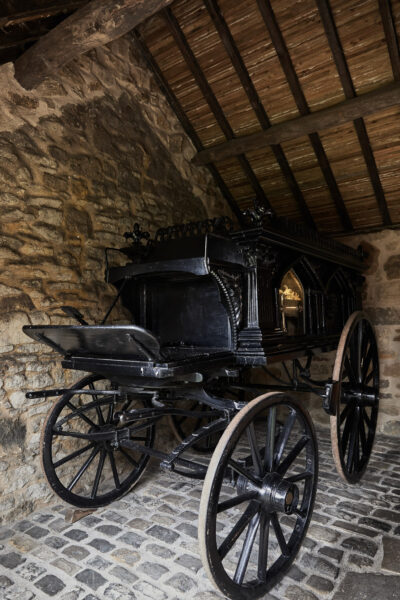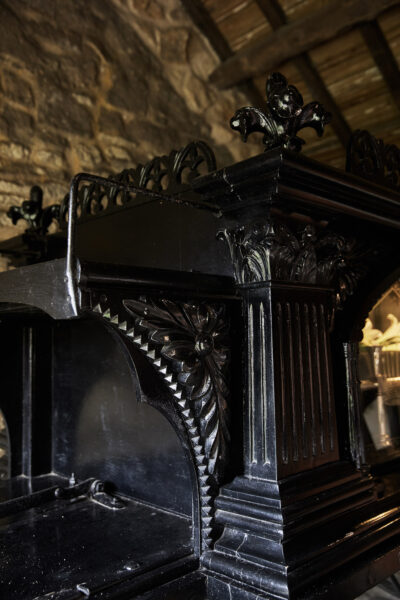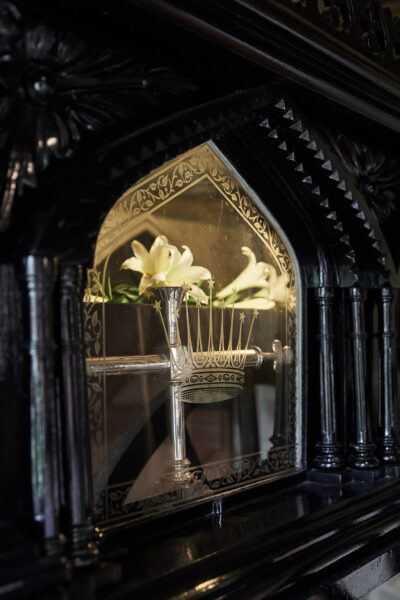We often think of the Victorian fascination with mourning as starting with the death of Prince Albert in 1861. However, a very special object at Ryedale Folk Museum is a reminder that these preoccupations were already in place.
Though nowadays death is often viewed as a taboo subject best avoided, in the eighteenth and nineteenth century this was not the case. Few things carried as much social stigma in Victorian Britain as the ‘Pauper’s Funeral’. To avoid this fate, people needed to plan their ‘send off’ whilst they were still very much alive.
It’s within this context that we should best explore the fascinating story of the Farndale Hearse.

The Farndale Hearse at Ryedale Folk Museum
During the eighteenth century, it was fashionable for the gentry to have nocturnal burials – these must have been dramatic affairs. Members of the Cholmley family of Roxby Castle, Thornton-le-Dale, for example, are known to have been buried by torchlight.
This custom had waned by Victorian times, but the theatricality of funerals remained, with mourners often expecting to see the whole spectacle of black horses pulling an elaborate black hearse.

Woodwork detail on the Farndale Hearse
Such a funeral was clearly out of reach for most ordinary people, and especially for many of the inhabitants of Farndale. Farndale remains an isolated moorland community, with hamlets and farms scattered across the valley, geographically much the same as during Victorian times. But in 1839, the community came together to organise the purchase of a hearse. They also funded a construction to house it. Today, it can be seen outside the Undertaker’s office at Ryedale Folk Museum.
From meeting records, it’s clear that to achieve this they had to create a method of subscription that would be viewed as ‘fair’. Each household would be asked to pay according to its means. For this initial outlay, a family would be entitled to use the hearse, with just a small cleaning charge per use.
Elsewhere during the period, we see this ‘cooperative’ approach to funeral and mourning customs in burial clubs, for example. These allowed members to make small, regular contributions against costs.
In the case of the Farndale Hearse, the inhabitants were divided into nine classes based on the poor rate.
The first class, earning over £60 per annum, were asked to pay 12s subscription. The second income bracket was for those earning between £50 and £60 per annum, with an 11s subscription.
Unsurprisingly given the rural location of Farndale, the first six classes appear to be described as farmers, with the seventh noted as ‘cowkeepering’, with a subscription of 2s 6d. The final two groups were cottage-dwellers, asked to pay 1s 6d and 1s 0d subscription. A more substantial donation of £5 was also received from local landowner Lord Feversham.
In Farndale, the journey posed practical difficulties due to the scattered distribution of inhabitants. The community purchase is therefore a sensible solution, but certainly an unusual one. Elsewhere in the region, for example in Goathland, we know that waggons were used for this purpose, sometimes painted black.
Like other aspects of life, funeral customs tended to filter downwards as the rest of society aspired towards standards set by the gentry, or perhaps even by royalty. But what is fascinating about the Farndale Hearse is that it offered the same final journey for everyone. Democratising the process, the hearse allowed access for all (or almost all) to the communal asset, a wonderful piece of craftsmanship, with highly-elaborate carvings, etched glass and silver-plated holders for bearing flowers.

The hearse – details and side window
It must also have been a huge relief for families, expected to make every effort to support the dead to depart peacefully. Importantly, the expense of the hearse would not fall to the relatives in Farndale, but be prepaid, easing one of the burdens and expenses for the family.
All photos by Olivia Brabbs Photography
